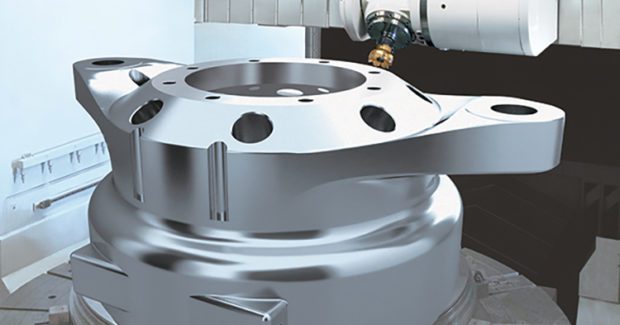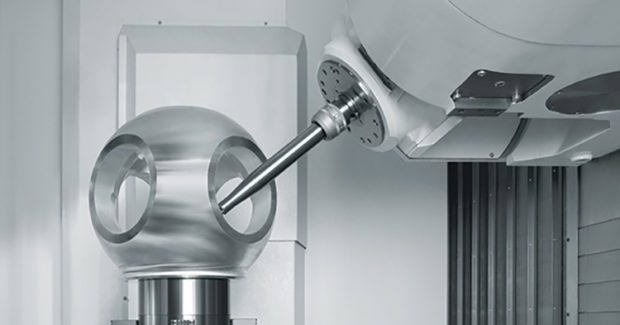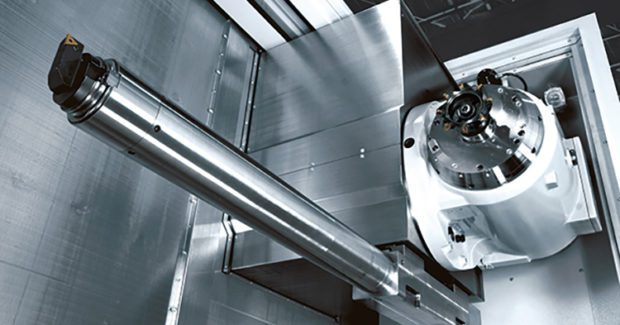The Fine Tuning Evolution of Multi-tasking Machines
Think this technology has leveled off? Think again. Some of the latest advancements include integral-motor roller cam-style turrets, 90 deg-configured turrets, enhanced lower turrets, direct-drive milling spindles and servo drilling tailstocks. And that’s not all.
Posted: May 29, 2017
Multi-tasking machine tool technology has revolutionized manufacturing and continues to play a critical role in today’s truly progressive job shops. Besides the amazing gains in productivity, multi-tasking technology has catapulted shops, especially smaller ones, to levels where they can easily machine the most complex parts in the world and do so cost-effectively. Current multi-tasking machine configurations can incorporate a veritable slew of components and capabilities: from twin turning spindles, multiple tool turrets with rotary tool stations and Y-axis off-centerline capability to tilt/rotary B-axis milling spindles, rotary/tilt tables and large capacity tool magazines. And while some shops may believe the technology has leveled off, quite the opposite holds true as machine tool builders refine and improve upon the designs of multi-tasking machines every day.
Some of the most recent of these design advancements in multi-tasking machine tool technology include integral-motor roller cam-style turrets, 90 deg-configured turrets, enhanced lower turrets, direct-drive milling spindles and servo drilling tailstocks. Additional advanced capabilities are simultaneous milling with upper and lower machine turrets and long drilling operations. Integral-motor turrets that use roller gear cam drive systems deliver smooth, high-speed, high-accuracy digital indexing as well as expandability. Such versatile turrets typically house 12 tool positions with the ability to expand up to 24. Increased tool capacity equals longer uninterrupted run times and the ability to use more common tooling, which helps reduce overall tooling inventory.
This innovative turret design eliminates the need for curvic/index couplings, and expandability is possible because the turret indexes digitally to any position without changes to its housing. And once in position, integral hydraulic clamping systems are typically used to ensure maximum rigidity. An integral-motor, roller gear-cam turret positioned 90 deg and parallel – as opposed to perpendicular – to a multi-tasking machine’s turning spindle provides incredible capabilities, especially when paired with digitally driven Y-axis. In addition to the expandability gained from a digitally driven turret, the 90 deg configuration offers shops a cost-effective Y-axis machining alternative. Such capability would otherwise involve a bit higher priced machine.
Roller gear cam technology drives the turret for infinite radial positioning. This special configuration allows the turret to position in the Z-axis and A-axis to perform Y-axis machining. The configuration eliminates the need for an actual Y-axis slide mechanism, which makes the machine cost effective without any performance sacrifices. As is the case with their upper counterparts, lower turrets on multi-tasking machines also continue to evolve and expand in terms of capabilities as well as their tooling capacities. Lower turrets are now more robust and powerful and typically offer up to nine tool positions with options for live milling spindles.
https://youtu.be/VXrEyMqrlAU
Some machine builders configure turrets on 45 deg slants. This maximizes the turret’s machining load capacities and provides ample accessibility to the machine’s spindle and room for part transfers from main to second turning spindles. For increased productivity and part processing versatility, lower turrets can work simultaneously with upper turrets on the same workpiece. Or, lower turrets can work in combination with a machine’s milling spindle that can be applied to either side of the machine’s headstock to further reduce machining cycle times.
Today’s multi-tasking machine turrets sport rotary tool spindles that are faster and more powerful than their predecessors thanks to new direct-drive technology. Direct-drive mill motors deliver up to 24 percent faster spindle rpm and 60 percent higher torque levels. All of which equates to boosts in processing versatility, productivity and tool life along with improved part surface finish quality. Now as commonplace, shops can acquire multi-tasking machines with turret rotary-tool spindles that deliver 10 hp, 6,000 rpm as standard. Or they can opt for those that deliver as much as 10,000 rpm and generate up to to 52 ft-lb of torque.
The latest NC servo-driven tailstocks enable automated processes on today’s multi-tasking machines. These tailstocks are fully programmable and run on their own AC servomotors and ball screws. Through part programs, the tailstocks can extend to known positions and with specified approach feed rates and make contact with workpieces at consistent holding pressures. Because of their positive independent drive systems, these tailstocks can also drill holes on shaft centerlines, which adds versatility to the jobs a multi-tasking machine can process. In most instances, tailstock thrust settings are adjustable in increments of specific foot pounds of force. This allows shops to set thrust levels according to workpiece material and shape to eliminate the risk of part damage while simultaneously providing safe and secure holding and support.
Or, shops can adjust thrust settings on-the-fly while tailstocks are engaged, thus allowing for drilling, boring and honing operations that would otherwise involve tools in the machine’s tool turret. So tailstocks with such operational capability, in turn, open up positions in machine tool turrets.
As an increasing number of shops face longer, larger and more complex shaft-type workpieces, current multi-tasking machines can offer extended bed lengths teamed up with innovations such as long drill/tool stockers. These machines significantly boost processing speed and efficiency for those challenging parts. For deep hole operations, long-tool stockers allow machines to handle and store multiple tools – typically as many as three and each about 40 in long. Stockers are located above the machine’s second spindle or, depending on machine version, its tailstock to keep tools well out of the way, yet quickly and easily accessed automatically.
When machine tool builders refine and improve upon multi-tasking machine designs, processing versatility increases, and the core benefits of multi-tasking are further enhanced. Combining operations reduce inaccuracies that can occur when moving parts across multiple workstations, as well as eliminate work-in-process inventory that might otherwise linger between standalone machine tools. For today’s job shops, multi-tasking machines allow them to accomplish more with less and boost competitiveness.


















